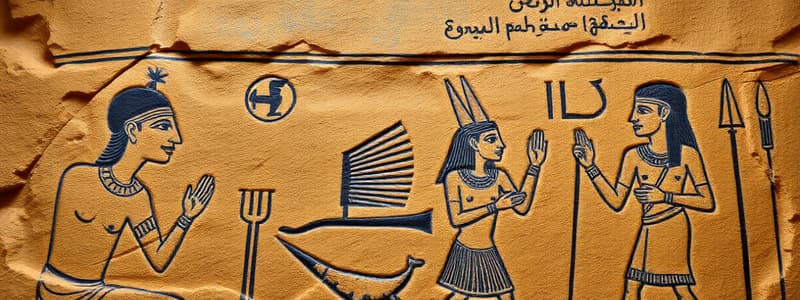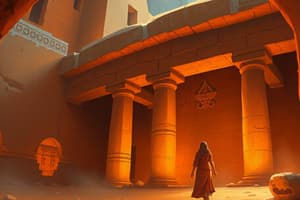Podcast
Questions and Answers
What key characteristic distinguishes Roman art from Greek art?
What key characteristic distinguishes Roman art from Greek art?
- A focus on mythological themes
- The exclusive use of bronze for sculptures
- The creation of large public sculptures
- An emphasis on realism and everyday life (correct)
Which of the following artists is best known for their relatable and sensual approach to sculpture during ancient Greece?
Which of the following artists is best known for their relatable and sensual approach to sculpture during ancient Greece?
- Praxiteles (correct)
- Phidias
- Polykleitos
- Imhotep
Which media were primarily utilized by Greek artists to achieve fine detail in their works?
Which media were primarily utilized by Greek artists to achieve fine detail in their works?
- Glass and textiles
- Bronze and wood
- Marble and pottery (correct)
- Frescoes and clay
What was a primary purpose of Roman art beyond decoration?
What was a primary purpose of Roman art beyond decoration?
Which characteristic describes the function of Greek art in public spaces?
Which characteristic describes the function of Greek art in public spaces?
What function did cave art most likely serve in early human societies?
What function did cave art most likely serve in early human societies?
Which of the following materials was NOT typically used in Egyptian art?
Which of the following materials was NOT typically used in Egyptian art?
How did the hieratic scale function in Egyptian art?
How did the hieratic scale function in Egyptian art?
What is a common characteristic of cave art?
What is a common characteristic of cave art?
What key element was commonly found in Egyptian art to convey meaning?
What key element was commonly found in Egyptian art to convey meaning?
What aspect reflects cultural values in ancient art forms?
What aspect reflects cultural values in ancient art forms?
Which of the following statements is true about artists of cave art?
Which of the following statements is true about artists of cave art?
Which statement best distinguishes Egyptian art from cave art?
Which statement best distinguishes Egyptian art from cave art?
What is a defining characteristic of Chinese painting?
What is a defining characteristic of Chinese painting?
Which printing technique is primarily associated with Ukiyo-e?
Which printing technique is primarily associated with Ukiyo-e?
What notable cultural aspect does Ukiyo-e reflect?
What notable cultural aspect does Ukiyo-e reflect?
Which of the following materials has been traditionally favored in Chinese painting?
Which of the following materials has been traditionally favored in Chinese painting?
What main purpose does Chinese painting serve according to its characteristics?
What main purpose does Chinese painting serve according to its characteristics?
Which artist is recognized for significant contributions to Chinese painting during the Tang dynasty?
Which artist is recognized for significant contributions to Chinese painting during the Tang dynasty?
Which styles are primarily associated with Chinese painting?
Which styles are primarily associated with Chinese painting?
What artistic technique do Ukiyo-e artists use to create color gradients?
What artistic technique do Ukiyo-e artists use to create color gradients?
What concept does the term 'Ukiyo' refer to in the context of Ukiyo-e?
What concept does the term 'Ukiyo' refer to in the context of Ukiyo-e?
In which period did Ukiyo-e emerge in Japan?
In which period did Ukiyo-e emerge in Japan?
What was a primary focus of Roman art?
What was a primary focus of Roman art?
Which architectural innovations are prominently associated with Roman art?
Which architectural innovations are prominently associated with Roman art?
What was one significant purpose of medieval art?
What was one significant purpose of medieval art?
What medium was NOT commonly used in medieval art?
What medium was NOT commonly used in medieval art?
Which significant figure contributed to the development of Roman arts?
Which significant figure contributed to the development of Roman arts?
How did Roman art reflect cultural values?
How did Roman art reflect cultural values?
What is a characteristic style of medieval art?
What is a characteristic style of medieval art?
In what way did the purpose of Roman art differ from medieval art?
In what way did the purpose of Roman art differ from medieval art?
Which medium was used to convey religious narratives in medieval cathedrals?
Which medium was used to convey religious narratives in medieval cathedrals?
Why did many medieval artists remain anonymous?
Why did many medieval artists remain anonymous?
Flashcards
Art Movement
Art Movement
A group of artworks with similar styles, ideas, and techniques.
Ancient Art
Ancient Art
Art created by early civilizations, from prehistoric times to classical antiquity.
Cave Art
Cave Art
Art painted on cave walls, often depicting animals and symbols.
Cave Art Media
Cave Art Media
Signup and view all the flashcards
Egyptian Art Focus
Egyptian Art Focus
Signup and view all the flashcards
Hieratic Scale
Hieratic Scale
Signup and view all the flashcards
Egyptian Art Media
Egyptian Art Media
Signup and view all the flashcards
Egyptian Art Symbolism
Egyptian Art Symbolism
Signup and view all the flashcards
What's the dominant style of Chinese painting?
What's the dominant style of Chinese painting?
Signup and view all the flashcards
What media is often used in Chinese painting?
What media is often used in Chinese painting?
Signup and view all the flashcards
What does Ukiyo-e mean?
What does Ukiyo-e mean?
Signup and view all the flashcards
What is a key characteristic of Ukiyo-e?
What is a key characteristic of Ukiyo-e?
Signup and view all the flashcards
What is the purpose of Chinese painting?
What is the purpose of Chinese painting?
Signup and view all the flashcards
What technique is used in Ukiyo-e to create depth?
What technique is used in Ukiyo-e to create depth?
Signup and view all the flashcards
What is the significance of Wang Wei in Chinese art?
What is the significance of Wang Wei in Chinese art?
Signup and view all the flashcards
How is Ukiyo-e produced?
How is Ukiyo-e produced?
Signup and view all the flashcards
How are Asian art forms connected?
How are Asian art forms connected?
Signup and view all the flashcards
What do Chinese paintings often include?
What do Chinese paintings often include?
Signup and view all the flashcards
Roman Portraiture
Roman Portraiture
Signup and view all the flashcards
Roman Architectural Innovations
Roman Architectural Innovations
Signup and view all the flashcards
Roman Art Purpose
Roman Art Purpose
Signup and view all the flashcards
Augustus's Artistic Legacy
Augustus's Artistic Legacy
Signup and view all the flashcards
Medieval Art Influence
Medieval Art Influence
Signup and view all the flashcards
Medieval Art Media
Medieval Art Media
Signup and view all the flashcards
Medieval Art Style
Medieval Art Style
Signup and view all the flashcards
Medieval Art Purpose
Medieval Art Purpose
Signup and view all the flashcards
Anonymous Medieval Artists
Anonymous Medieval Artists
Signup and view all the flashcards
Medieval Illuminated Manuscripts
Medieval Illuminated Manuscripts
Signup and view all the flashcards
Imhotep's Legacy
Imhotep's Legacy
Signup and view all the flashcards
Greek Art Emphasis
Greek Art Emphasis
Signup and view all the flashcards
Contrapposto
Contrapposto
Signup and view all the flashcards
Roman Art Realism
Roman Art Realism
Signup and view all the flashcards
Mosaics
Mosaics
Signup and view all the flashcards
Study Notes
Ancient Art
- Cave art emerged around 40,000 years ago, marking the start of human art.
- Lascaux Cave in France displays animal, human, and abstract art.
- Early humans used art for communication and connection with their environment.
- Cave art media included natural pigments (ochre, charcoal, minerals) mixed with animal fat or water, applied with primitive tools.
- Cave art styles feature simple forms, silhouettes, outlines, and dynamic animals (bison, horses, deer).
- Geometric patterns and hand stencils are also common.
- Purpose likely included hunting rituals and documenting significant events.
- Artists remain unknown, but works reflect collective cultural effort.
Egyptian Art
- Egyptian art flourished from 3000 BCE to 30 BCE, focusing on the afterlife and honoring gods.
- Media included stone, wood, metal, and papyrus.
- Stone was used for sculptures and monuments, wood for smaller artifacts, metal for decorative items, and papyrus for painting and writing.
- Styles emphasized the hieratic scale (larger figures = higher status).
- Figures often shown in frontal poses, with heads and legs in profile.
- Symbolism was crucial, with colors and icons carrying specific meanings (green for fertility/rebirth).
- Purpose included religious and funerary purposes, used in temples and tombs to aid the deceased in the afterlife.
- Imhotep was a significant architect who designed the Pyramid of Djoser (first large stone building, influenced Egyptian art greatly).
Greek Art
- Greek art (800 BCE to 30 BCE) influenced Western culture through emphasis on beauty, humanism, idealized forms.
- Media included marble and bronze for sculpture, pottery (black-figure/red-figure).
- Styles used naturalism in sculpture (contrapposto posture).
- Purpose revolved around human achievements, mythologies, and gods, often displayed in public spaces like temples.
- Phidias and Praxiteles were important sculptors.
Roman Art
- Roman art (500 BCE to 500 CE) adapted Greek styles but emphasized realism and everyday life.
- Media included marble for sculptures, frescoes for wall paintings, and mosaics for flooring.
- Styles featured portraiture to capture likeness, and new architectural innovations like arches and domes.
- Purpose encompassed conveying power, achievements, cultural values honored emperors, and reflected social standing.
- Augustus, although no specific works are mentioned, contributed to Roman art.
Medieval Art
- Medieval art (500–1400 CE) was influenced deeply by the church, focusing primarily on religious themes.
- Media included illuminated manuscripts, stained glass windows, and sculptures decorating church façades.
- Styles emphasized flat, symbolic representations with emphasis on outlines and bold colors, over realistic proportions (Prioritized spirituality).
- The purpose was to educate and inspire religious devotion; art was used to convey biblical stories and teachings.
- Monks like the Limbourg brothers were important contributors (illuminated manuscripts).
Asian Art (Specifically Chinese Painting and Japanese Print-making)
- Asian art expresses diverse religions, philosophies and thousands of years of cultural heritage.
- Chinese painting emphasized harmony with nature and philosophical concepts using ink and brush on silk/paper.
- Landscape and calligraphy were key styles.
- Purpose included expressing spiritual and philosophical concepts and conveying essence of nature, balance, transient nature of life.
- Ukiyo-e (Japanese printmaking) used woodblock printing to capture everyday life, people (bijin), landscapes, kabuki performers, creating vibrant colors and perspective.
- Key figures included artists like Katsushika Hokusai and Utagawa Hiroshige.
Studying That Suits You
Use AI to generate personalized quizzes and flashcards to suit your learning preferences.




